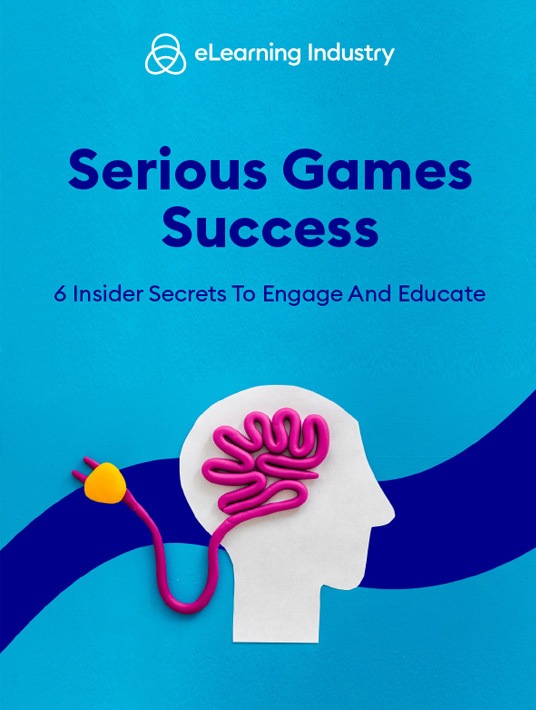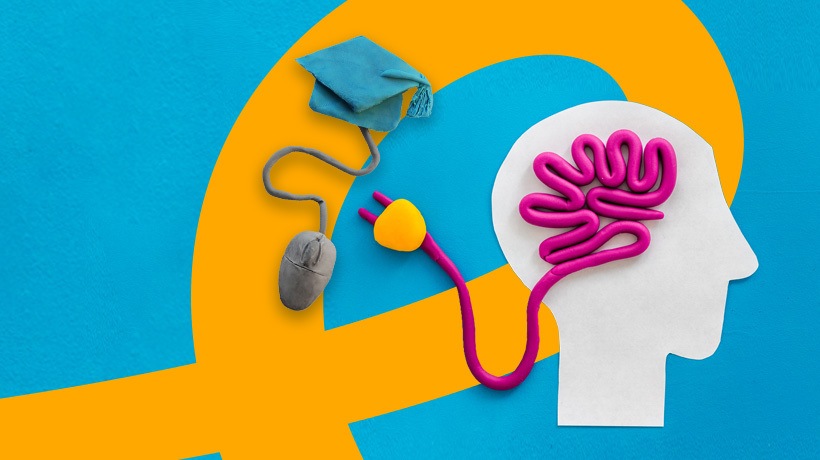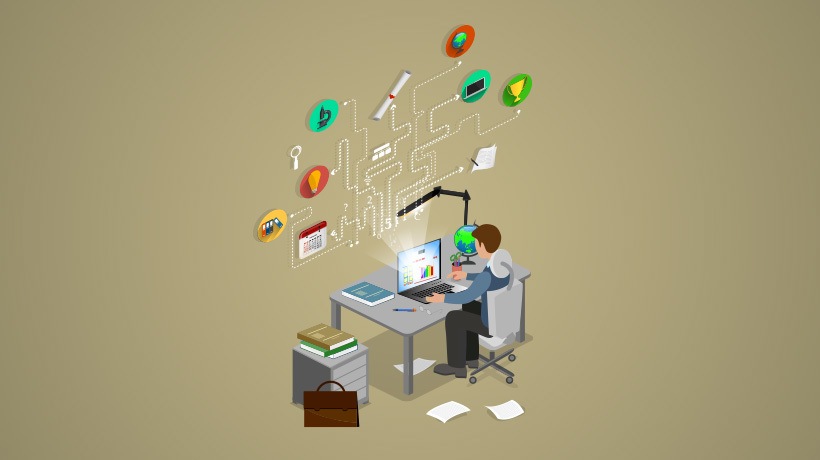How Serious Games Engage And Educate Remote Employees
There’s a buzz building around serious games and for good reason. They can help you engage, inspire, and motivate your staffers, even if they work remotely and have negative preconceptions about online training. But what is a serious game, fundamentally, and how can you apply it in your L&D program? Is there a reason why they’re such a powerful tool for behavioral change and positive reinforcement? And how can you implement serious games rapidly to train your remote workforce and bridge crucial gaps?
This article has the answers to all your pressing questions. We’ll also explore the key differences between serious games and gamification, since the line is often blurred between these two L&D approaches. We will then highlight some prime successful serious games examples that you can use to edutain your teams. So, let’s jump right into the amazing world of serious game development for corporate eLearning. Here's a sneak preview of what you'll find in this epic guide...
- What Are Serious Games And How Do They Fit Into Your L&D Strategy?
- Immerse And Inspire: The Psychology Behind Successful Serious Games
- Are Online Training Games The Best Approach For Remote Talent Development?
- How To Design Engaging L&D Experiences: 10 Serious Gaming Best Practices For Fast Implementation
- 5 Differences Between Serious Games Versus Gamification
- 10 Amazing Serious Games Examples For Corporate eLearning

1. What Are Serious Games And How Do They Fit Into Your L&D Strategy?
What is a serious game? Serious gaming experiences must meet a few requirements. First and foremost, they’re geared more toward professional development than entertainment. That said, fun is still a major factor to consider. Online training games also support L&D objectives and goals so that employees can apply what they’ve learned in a practical context. In other words, formidable foes are replaced by on-the-job challenges, like difficult customers, coworker conflicts, and complex tasks. Here are 5 ways to incorporate serious gaming experiences into your L&D program.
Performance Management
Serious game development is ideal for performance management and support because it provides discreet feedback. Employees can identify personal areas for improvement as they progress through the game. For example, maybe there’s a better way to resolve the virtual customer’s issue. They also have the chance to spot negative habits or limiting beliefs that are holding them back in the workplace. Such as racing through the task, only to realize that they’ve made crucial errors in the process.
Knowledge Reinforcement
Serious online training games help cement pre-existing knowledge and refresh employees’ memory. For instance, they need to apply what they’ve learned in a real-world context to resolve the in-game challenge. Or dig into their long-term memory banks to complete the task and achieve the best results. Games also allow them to build on their mental schema by scaffolding knowledge. As an example, they must perform the next logical step in the process or draw conclusions based on past experience.
Real-World Application
One of the most convincing reasons to use successful serious games in your strategy is to encourage practical application. Employees get hands-on experience remotely. But they’re also able to test different approaches in a risk-free setting. For instance, try unique conflict resolution techniques to appease the unhappy customer. Serious gaming even lets them master new work equipment and software so that they can troubleshoot issues on the job.
Risk Mitigation
The obstacle that many organizations face is imparting experience without diminishing their bottom line or brand image. For example, an employee doesn’t know how to apply compliance regulations on the job. So, they break the rules and incur fines and penalties. In some cases, they may even cause injuries or fatalities due to their limited experiential knowledge. Successful serious games are based on real-world situations. Meaning that you can mitigate risks because staffers are aware of potential hazards.
Mistake-Driven Learning
Effective eLearning games are all about making mistakes and learning from them. Staffers are able to take calculated risks that may not pay off. But they still get something from the experience. They can evaluate their own performance and see where they went wrong and how to improve. Especially if you pair it with targeted feedback and online training recommendations.

2. Immerse And Inspire: The Psychology Behind Successful Serious Games
There’s actually a science behind online training games that makes them popular for employee development. It’s all based on our human characteristics. Most of us seize every opportunity to immerse ourselves in fantastical worlds and battle it out with other players. Or to solve a mystery by looking for clues and interrogating virtual suspects. In short, games give us the chance to escape the real world for a while and test our mettle. While serious gaming might be based in reality, it still triggers or innate human traits. This makes it a powerful tool for professional development.
Built-In Feedback
Most of us look for direction. Even go-getters like to receive feedback that helps them focus on personal pain points as well as identify hidden strengths. It’s even better when this feedback is discreet and happens organically. For instance, employees might not progress to the next level or fail to achieve the best-case scenario. Online training games fulfill this need by giving staffers autonomy so that they can reflect on their performance. In addition, they experience the positive or negative repercussions of their actions in a safe setting.
Intrinsic Motivation
Intrinsic motivation does not involve external forces. In fact, it’s often fueled by our internal drive to be better and achieve our full potential. Successful serious games don’t involve public recognition or monetary rewards. Instead, they push employees to continually improve and compete against their past selves. For example, they get a higher score or fix negative behaviors they discovered the last time around. It may only be a game, but it’s a catalyst for change thanks to the fact that’s enjoyable, entertaining, and personally rewarding. That said, you can still incorporate leaderboards and points if you do want to spark friendly competition.
Goal Achievement
Humans enjoy the process of setting goals and achieving them. That’s why many of us create New Year’s resolutions—even if the success rate isn’t stellar. We want to better ourselves, and goals are the stepping-stones to personal fulfillment. Successful serious games involve mini-aims that give us that same thrill. Employees are able to set their sights on the finish line and avoid all the obstacles along the way. However, when they achieve the best possible outcome it’s not just an in-game victory as they learn something about themselves or develop crucial skills they can apply on the job.
Sense Of Accomplishment
Accomplishing what you set out to do is another psychological principle behind serious gaming. Staffers are able to give themselves a pat on the back when they complete the activity and reflect on their performance. This is why it’s so crucial to make challenging games that push them slightly out of their comfort zone. A serious gaming victory makes it all worthwhile because they’ve closed a skill or performance gap.
Instant Gratification
Yet another common human characteristic is the need for instant gratification. At least, we prefer to have things pay off right away instead of waiting for rewards. Serious eLearning games are usually quick and fast-paced. For instance, employees complete the game in 3 minutes so that they can apply their newfound knowledge immediately. This gives them instant gratification because they can evaluate results and receive targeted information on-the-spot.
Self-Esteem
Even small victories in-game make employees feel more self-assured. They know that they’ve accomplished something. This is why so many of us play video games. Defeating the final boss or solving a puzzle proves that we have what it takes. That we can handle any challenge that comes our way and learn from the experience. The same rule applies to serious gaming. For instance, the customer service employee is able to appease an angry customer. They’ve used all their skills and expertise to handle a difficult situation. So, their self-esteem rises since they know they can handle similar challenges in the workplace.
Productivity Primer
eLearning games put employees in a more positive and productive headspace. They’re more creative because the game has forced them to think laterally. As an example, a staffer starts their workday with a quick serious game to brush on their skills. This primes them for upcoming tasks and sparks creativity. Plus, they can always use the JIT serious game online training library if they run into any problems.
3. Are Online Training Games The Best Approach For Remote Talent Development?
Serious games aren’t the answer to everything. You may need to use a different ID approach to achieve your objectives and fill pre-existing gaps. However, serious game development is often a cost-effective strategy for remote talent development since it gives staffers the opportunity to evaluate their skills and performance behaviors. Not to mention, lose themselves in a gaming environment that mimics real-world situations and stressors. Below are 7 perks serious gaming brings to your telecommuting workforce.
Engage Remote Staffers
Employees expect to see PDF manuals and long presentations when they log into the LMS. Successful serious games catch them off guard and prompt them to actively participate. They engage in online training because games are immersive, interactive, and entertaining, even if they cover dull compliance topics that usually bore them to tears. This makes them ideal for remote talent development because staffers get maximize L&D benefits. They’re more likely to complete the activity and bridge emerging gaps because it’s online training in disguise.
Provide JIT Support
One of the most common applications for eLearning games is on-the-spot support. It can help supplement courses or live events since employees are able to focus on specific skills or tasks and then move on to the next topic. For example, a serious game may center on interpersonal skills in the customer service department. Call center staffers spend 5 minutes interacting with virtual personas and resolving complaints. All while building their active listening and communication skills.
Bridge Performance Gaps
Serious training games bring hidden gaps out into the open. But they also help target common performance issues based on the employee’s role or department. For instance, your sales staffers have trouble sealing the deal. You trace it back to ineffective persuasion, negotiation skills, and lack of product know-how. Thus, you can use serious gaming experiences to zero in on these pain points autonomously.
Identify Top Performers
Which employees stand out and should be on the management fast-track? Serious games in corporate eLearning allow you to identify top staffers who are ready to step up. They outperform their skills and continually improve. Their serious game scores and performance metrics provide clear evidence. These stellar employees might also be prime candidates for peer coaching or mentoring. Furthermore, games point out their strengths and weakness so that you can personalize their development plan.
Foster Emotional Connectivity
You need employees to connect with online training on an emotional level. At least, if you want them to assign meaning and get the most benefit from your L&D program. Online training games allow them to get lost in the experience. To immerse in the storyline and feel the real-world pressures. As a result, they’re more likely to remember the key takeaways and actively recall them when it really counts. In short, games prep them for on-the-job stressors and build self-confidence.

Eliminate External Distractions
A major telecommuting setback is distractions. Employees need to focus on the task and get the job done, but external forces pull them away. The same goes for their online training. Fortunately, successful serious games encourage them to let everything else fade away and concentrate on the in-game scenario. They can absorb the information more effectively because it’s a multisensory experience, from the tactile game controls to the immersive visuals and sounds.
Build Lateral Thinking And Problem-Solving Skills
eLearning games are inherently good for lateral thinking abilities because employees think outside the box. They must be able to approach the problem or situation from different angles, then determine the best strategy. This also involves a high degree of problem-solving and creative reasoning. For instance, the employee must choose the perfect product based on customer pain points. Or try to resolve an IT issue before time runs out.
4. How To Design Engaging L&D Experiences: 10 Serious Gaming Best Practices For Fast Implementation
Before deciding if serious games are the best approach, you should know what you’re getting into. What does it take to create a memorable and awe-inspiring game for your remote staffers? Especially if you’re racing the clock and working with limited resources. These serious games best practices can help you expedite implementation without compromising employee engagement. If you always want to have our Serious Games Success guide with you, you can download it here.
Keep It Relevant And Relatable
Traditional games often stretch reality and explore hypothetical situations. But serious gaming experiences need to be relevant and relatable for every employee. Sure, you can include what-ifs to help them prepare for workplace emergencies. However, the story needs to resonate with them on a personal level and put everything into context. As an example, they need to learn how to deal with irate customers over the phone. Thus, the game should involve actual customer personas and situations others have encountered. You can even use recorded calls or personal anecdotes to frame your game and enhance realism.
Focus On A Single L&D Objective
Even epic serious games should center on a single goal or objective. You may be tempted to create a half-hour game that makes employees lose track of time and fully immerse. But online training games are best in small doses. This gives staffers the chance to concentrate on specific subtopics or L&D aims. Then absorb all the information they need to improve their productivity instead of having to spend their entire lunch break in the simulation or scenario. Focusing on a single objective also simplifies content maintenance. You can quickly modify the template to include new rules or protocols rather than overhauling the entire decision path to make room for changes.
Create Memorable Characters
Developing characters for successful serious games is a slippery slope. They need to be memorable and realistic, but they can’t steal the show. To illustrate, that unhappy customer or coworker should present a challenge. But they shouldn’t start yelling obscenities or have quirky personality traits for the sake of entertainment. Ideally, characters move the story along and help staffers build related skills naturally. You can even use video clips or cut-out characters to put a face to the name.
Include A Story Arc
Like all well-written stories, your serious eLearning game needs to have an introduction, challenge, and resolution. This narrative arc moves employees through the action and features decision points, dialogue, and outcomes. Above all, the arc should build tension and apply pressure in small doses. Not enough to overwhelm learners, but still enough to mimic real-world tension. This way, they’re ready to face any challenge that comes their way on the job.
Add The Element Of Risk
Employees should have a stake in the game (pun intended). Adding the element of risk encourages staffers to take chances based on their experience and expertise. What happens if they offer this new product instead of the gold standard? Should they bend the warehouse safety rules if it saves time? By taking risks, employees learn more about themselves and the importance of company policies. For instance, those warehouse rules are in place to prevent accidents and keep everyone safe. Even if they add another minute or two to the process.
Use The Right Game Mechanics
Serious games typically don’t involve rewards, which I’ll cover in the next section. However, they do have game mechanics to provide structure and propel the player forward. The key is to choose the right mechanic for the task. This is based on employee preferences, subject matter, and desired performance behaviors. Should you use levels to mark milestones and separate task steps? Or should you assign points for in-game tasks so that employees can monitor their progress?
Invest In A Rapid Authoring Tool
There are many rapid authoring tools that feature templates and assets. This can reduce serious game development costs and time. However, you should do your homework and research popular features and pricing models before you buy as well as set an accurate budget and get L&D team feedback before you start searching. Another best practice is to invest in an LMS that supports games and real-world activities.
Don’t Raise The Stakes Too High
There should be some element of stress involved if the situation calls for it. However, you shouldn't apply too much pressure. Employees need to understand that every action or decision has consequences. But not to the point that they have a panic attack in the middle of the game. You must find a happy medium. For example, you include a timer because they need to work quickly without making too many mistakes. However, you should leave some wiggle room so that they can explore and try different techniques. Also, try to avoid extreme worst or best-case scenarios regarding outcomes. Offering the wrong product isn’t the end of the world, but it might hurt your profit margin.
Repurpose Assets
You probably have resources that you can reuse for your serious game design. Such as image, sound bites, and online training stories. These assets help reduce costs since you don’t have to source them from third-parties. You can also encourage employees to submit anecdotes and real-world examples that serve as inspiration. This gives staffers a sense of ownership too. Their stories are spotlighted in the serious game to foster in-house knowledge sharing.
Consider Outsourcing
Many organizations choose to outsource serious game development because they simply lack the resources or design skills. Hiring an eLearning content provider also speeds up the development timeline since they already have the necessary tools, templates, and assets. You don’t necessarily have to outsource the entire project either. Analyze all the tasks involved and determine which is more cost-effective. For example, conduct Training Needs Analysis and storyboarding on your own. Then bring them in to develop games based on your vision.
5. 5 Differences Between Serious Games Versus Gamification
Serious gaming and gamification are often used interchangeably. However, they’re vastly different strategies. While both tap into employee motivation and friendly competition, the similarities stop there. For example, games are typically a single learning unit and gamification is a more holistic design methodology. Let’s look closer at the differences between serious games versus gamification to see which is right for your remote employees.
Structure
Online training games are typically a supplementary standalone. They’re an individual activity employees can use to fill in the blanks and reinforce know-how. Gamification, on the other hand, is woven into the fabric of the course design. For example, learners receive badges or points for successfully completing the module. Or scoring high on the compliance exam. That said, you can incorporate successful serious games into a gamified online training course. Sort of like the eLearning equivalent of a Russian nesting doll; a comprehensive course with serious games inside that also feature game mechanics, like levels and a scoring system.
Incentivization
Serious games and gamification both involve incentives, but they go about it in their own way. As an example, completing a game is often a reward in itself. Employees have proven that they have the skills and knowledge to achieve the best results. On the other hand, gamification is more about the rewards themselves. Rewards that align with certain behaviors that you want to reinforce or encourage within your staffers. For this reason, neither strategy should be focused on monetary incentives. For that matter, earning a badge or point shouldn’t be as important as developing crucial skills.
Design Approach
One of the perks of using successful serious games is that you can develop them independently from your online training courses. They can exist on their own and serve distinct L&D purposes. This makes them easier and more cost-effective than gamification, in most cases. For example, you may have to overhaul your entire strategy to incorporate gamification elements like levels, badges, and leaderboards. This is due to the fact that employees must be able to earn points when they achieve certain milestones or meet the requirements.
L&D Application
The applications for serious games versus gamification are also quite different. Serious games are mainly used for positive reinforcement and quick topic introductions. For instance, a 3-minute game helps the player spot personal areas for improvement before they start the course. However, gamification is more about maintaining motivation and tracking employee progress. Serious gaming experiences are also ideal for engagement boosts throughout the course. For example, you may be dealing with dry subject matter that needs a little entertainment and immersion to spark their interest.
Outcomes
Since the applications are different, you can also expect to achieve different outcomes. Successful serious games are great catalysts for change. Staffers play the game and discover hidden pain points or test new approaches. They’re also ideal for JIT support and quick knowledge recaps. But gamification is often a long-term strategy that keeps employees on the right track as well as highlights emerging performance issues they need to address to improve workplace proficiency.
6. 10 Amazing Serious Games Examples For Corporate eLearning
Now that you know the fundamentals of online training games, how do you actually apply them in your strategy? Are there any successful serious games examples for corporate eLearning you can use to mitigate compliance risks? Or prompt your staffers to reflect on their personal performance and identify hidden gaps? Below are 10 creative gaming ideas you can employ to enact meaningful change and support remote work teams.
Problem-Solving Simulations
This serious game centers on practical problem-solving. Employees must assess the situation and choose the best course of action. Every decision leads them to a different outcome so that they can retry for better results. Or even just to test out their theories and assumptions to see where it takes them. You can use this idea for every department or job role by changing up the challenge. For instance, customer service employees must contend with a product return past the deadline. Do they break the rules for loyal customers? Are there any creative resolutions, such as offering them a discounted replacement? For this, they must understand company policy and evaluate the extenuating circumstances.
Customer Care Branching Scenarios
Every member of your team must know how to interact with customers and provide amazing CX. Even back-end employees, like warehouse or HR staffers, may have to help customers from time to time. Customer care branching scenario games equip them with all the essential skills and experience. For example, what should they do if a customer calls in and needs IT assistance? In healthcare industries, you can substitute customers with patients to enhance the quality of care. Such as how to handle insurance claims or help patients fill out the intake forms. Every choice they make brings them down a specific branching path. If they provide stellar customer care, they achieve the best outcome. If they lack the necessary skills or know-how, the virtual customer lowers their satisfaction score.
Product Knowledge Match-Up
Which product is best for this virtual consumer? How well do employees know your product line? Are there any add-ons they can offer to increase per-ticket sales? Product knowledge matching games put all the features, specs, and benefits into context. For instance, staffers are provided with a brief customer bio, such as their buying habits, budget, and pain points. You can even take it a step further and omit these details so that employees have to ask questions beforehand. Then they move on to the product match-up by choosing from your catalog. Once they make their decision, a list of upgrades, service plans, or complementary products appears on the screen. You can also use this game design approach for services versus goods. For example, insurance plans or vacation packages.
Project Management Mini-Games
These mini-games involve different aspects of Project Management. Covering the entire PM process from start to finish calls for an epic adventure versus bite-sized support. The first mini-game might center on gathering the team. Which virtual employees do you choose for which roles? The second mini-game dives into task assignments, while the third focuses on resource allocation. Employees can still complete all the games in succession for the full experience. Or simply tackle each game when they have the time and need to refresh their memory. The secret is to include challenges along the way so that they’re ready for real PM obstacles. Maybe one of the team members has all the right skills but they’re already booked. How can the Project Manager rearrange their schedule and delegate other tasks to free up their time?
Compliance Obstacle Course
If you give it some thought, compliance and obstacle courses are a natural fit. There are risks all around and employees must know how to spot them. Then they have to figure out how to mitigate them to avoid injuries or regulatory fines. So, develop an obstacle course serious game that features all the common hazards. To illustrate, your warehouse employees must identify all the potential risks in the storeroom, from the spill on the floor to a coworker mishandling products. Then they need to correct each issue using their pre-existing knowledge. Such as cleaning up the mess and putting up proper signage. Or recommending the gear to their colleague and reminding them of the safe handling policies. You can even create an obstacle course for HR staffers. This can feature sensitive documents left out in the open or a nearby coworker breaking the dress code.
Conflict Resolution Walkthroughs
This serious game flips the traditional task walkthrough on its head. In this case, employees must watch the conflict unfold and make decisions to "direct" the scene. For instance, they choose to intervene on the sales floor instead of pulling the employees aside. The next involves a full-blown argument in front of customers because they made the wrong decision. Thus, they learn from their mistake and don’t repeat it in the real world. You can also have them make decisions based on a story or real-world example. Then play the final scene which reflects their outcome. As an example, the story features 5 separate decision points that ultimately determine the final result. This way, you don’t have to develop as many scenes/video clips for each scenario.
Onboarding Quiz Show
New hires have the opportunity to earn points right off the bat with onboarding quiz shows. Of course, the main goal is to build their skills and bridge personal gaps before they clock in. Every episode of the game show focuses on a new topic. From compliance rules to company pillars. The final round features extra points or wagers to up the stakes. You can also use the quiz show approach for experienced staffers who need to refresh their memory. For example, if they need to prep for an upcoming certification renewal. Another option is to incorporate a leaderboard for bragging rights. Of course, friendly competition should be the focus instead of coworker rivalries.
WWYD (What Would You Do) Video Games
The most successful video games encourage players to walk in the protagonist’s shoes to see things from their point of view and make tough decisions. WWYD successful serious games are of the most cost-effective because they rely on brief video clips. Employees watch the scene unfold and then they answer a series of questions. For example, the video features bullying in the workplace. How would the employee handle the situation? Would they do things differently than the main character? Did anyone breach company policy? Was it really bullying? If so, who should they report it to?

Real-World Mysteries
There is a variety of ways you can approach this serious game design. Maybe employees become virtual detectives to gather clues and solve the mystery "Who violated the compliance regulations?" For example, the player is presented with three suspects. Each has a unique viewpoint and the staffer must evaluate all the puzzle pieces to find the culprit. It’s a more playful way to reinforce compliance concepts without downplaying the importance. Another strategy is to provide them with a real-world example, then ask them to fill in the ending. What is the best possible outcome and how can the protagonist resolve the issue?
Emergency Preparedness Recaps
I mentioned earlier to avoid worst-case scenarios and stick with practical problems. This is the one exception. Staffers need to be prepared for every emergency that may occur in the workplace. Even if that workplace is their home. For example, how do they prevent data breaches? What should they do if they realize that sensitive information has been compromised? These serious game recaps include a brief scenario and staffers must decide how to handle the situation while remaining cool, calm, and collected, of course. That said, you should still steer clear of far-fetched storylines and make it relevant. For example, telecommuting staffers no longer work in the office. So, they don’t need to know about safe egress protocols. Instead, focus on ergonomics and customer harassment situations.
Conclusion
Successful serious games in online training up the ante when it comes to employee engagement and motivation. They can even help you reduce employee turnover and boost knowledge retention. But only if you include all the right ingredients and consider the psychological factors involved. The good news is that you don’t have to develop serious game experiences in-house. There are plenty of eLearning content providers that can help you launch online training games rapidly and cost-effectively. Our exclusive directory for Gamification Design features the leading vendors for every industry and customer type. You can even evaluate ratings and reviews or peruse their list of online training solutions.
Download Serious Games Success: 6 Insider Secrets To Engage And Educate today and benefit from its top-notch tips.







